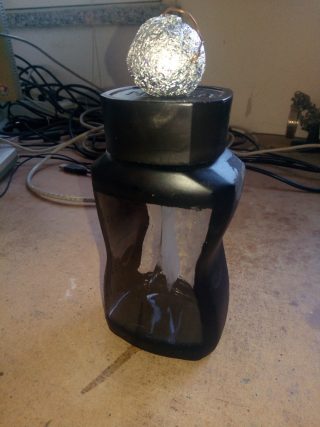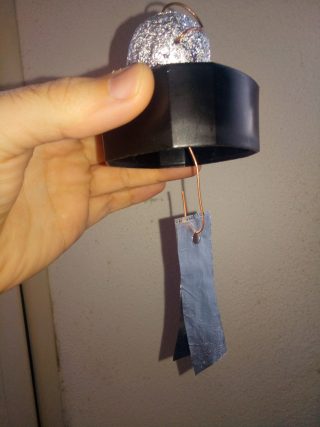Costruiamo uno strumento per segnalare un Ectoplama
Amici questa volta parleremo di plasma e precisamente di quello che in parapsicologia chiamano “Ectoplasma”. Il primo ad usare questo termine nel campo della parapsicologia e dello spiritismo fu il premio Nobel Charles Richet (1850-1935). Il termine ectoplasma indica una sostanza di natura sconosciuta, che secondo i fautori delle teorie paranormali uscirebbe dal corpo di alcuni medium in stato di trance e che spesso si materializzerebbe in figure visibili. Esso rappresenterebbe pertanto la forma corporea fluida nella quale talvolta si materializzano gli spiriti o le entità spirituali. Detto questo per me si tratta di ciarlatanerie da falsi medium ma, dal momento che questa sostanza viene descritta spesso come un qualcosa di simile all’ozono, ho pensato che possa essere invece plausibile un gas ionizzato. Sto applicando a questa teoria i miei studi di fisica e, partendo da questi presupposti, ho pensato a qualcosa capace di evidenziarlo.
Un Plasma altro non è che un gas ionizzato mediante scariche elettriche oppure delle radiofrequenze, caratteristica compatibile con la teoria sugli spiriti che emettono campi elettromagnetici. Mi sono detto quindi è possibile che uno spirito particolarmente forte possa ionizzare l’aria fino al punto di creare un plasma? Chiaramente ragionando in intorni davvero piccoli, non intendo nubi di plasma enormi.
Partendo da questo vi basti sapere che il plasma ha carica uniforme e quindi ho pensato a come si comporterebbe uno strumento semplice come un elettroscopio in presenza di questo fenomeno. Credo che le sue lamelle anche se per poco potrebbero vibrare evidenziandolo. Inoltre essendo le lamelle racchiuse all’interno di un’ampolla di vetro sono immuni da spifferi d’aria rendendolo abbastanza affidabile.
Per realizzarlo vi servirà:
- un foglio di carta stagnola
- un filo di rame rigido senza smalto
- un barattolo di vetro con tappo di plastica
Ricavate due lamelle di carta stagnola dimensioni 6×2 cm e praticate dei fori con una foratrice per carta alla sommità delle lamelle per poterli appendere. Forate il tappo del barattolo per far passare il cavo di rame, create un gancio nella parte interna dove appenderete le lamelle senza stingere, devono essere libere di muoversi e oscillare. Nella parte esterna fate una palla con la restante carta stagnola e infilateci dentro il cavo di rame. Chiudete il tutto. ed avrete una cosa di questo tipo:
La caratteristica di questo semplicissimo strumento è reagire alle cariche elettriche statiche facendo divergere le alette che tendono ad allontanarsi tra loro in maniera molto evidente. Per testare il funzionamento potete semplicemente avvicinare una bacchetta di plastica strofinata nella lana alla sua sfera e le alette reagiranno immediatamente. Per resettarlo è sufficiente toccare la palla e tutto si azzererà essendo messo a terra.
Con una telecamera puntata sulle sue alette potremmo essere sicuri che niente lo possa perturbare tranne un campo statico. Chiaramente si tratta solo di un esperimento, non vi è certezza che funzioni, ma la scienza è questo, trovare nuovi metodi e nuove strade.
We build a tool to report an Ectoplama
Friends this time we will talk about plasma and precisely what in parapsychology they call “Ectoplasma”. The first to use this term in the field of parapsychology and spiritualism was the Nobel Prize winner Charles Richet (1850-1935). The term ectoplasm indicates a substance of an unknown nature, which according to the proponents of paranormal theories would come out of the body of some mediums in a trance state and which would often materialize in visible figures. It would therefore represent the fluid body form in which spirits or spiritual entities sometimes materialize. This being said, it is a question of quirks from fake mediums, but since this substance is often described as something like ozone, I thought that an ionized gas could be plausible. I am applying my studies in physics to this theory and, starting from these assumptions, I have thought of something capable of highlighting it.
A Plasma is nothing more than a gas ionized by electric discharges or by radio frequencies, a feature compatible with the theory of spirits that emit electromagnetic fields. So I said to myself it is possible that a particularly strong spirit can ionize the air to the point of creating a plasma? Clearly reasoning in really small surroundings, I do not mean huge plasma clouds.
Starting from this you just need to know that the plasma has uniform charge and so I thought about how a simple instrument would behave like an electroscope in the presence of this phenomenon. I believe that its lamellae, even if for a while, could vibrate, highlighting it. Moreover, since the lamellae enclosed within a glass ampoule are immune to drafts of air making it quite reliable.
To make it happen you will need:
a sheet of foil
a rigid copper wire without enamel
a glass jar with a plastic cap
Obtain two sheets of foil paper size 6×2 cm and drilled holes with a drilling machine at the top of the slats to hang them. Drill the cap of the can to pass the copper cable, create a hook on the inside where you hang the slats without stinging, must be free to move and swing. In the outer part make a ball with the remaining aluminum foil and insert the copper cable inside. Close everything. and you will have something like this:
The characteristic of this very simple instrument is to react to static electric charges by making the wings that tend to move away from each other in a very evident way diverge. To test the operation, you can simply bring a plastic wand in the wool to its sphere and the fins will react immediately. To reset it, simply touch the ball and everything will be reset by being grounded.
With a camera pointed at its fins we could be sure nothing could disturb it except a static field. Clearly it is just an experiment, there is no certainty that it works, but science is this, find new methods and new ways.


